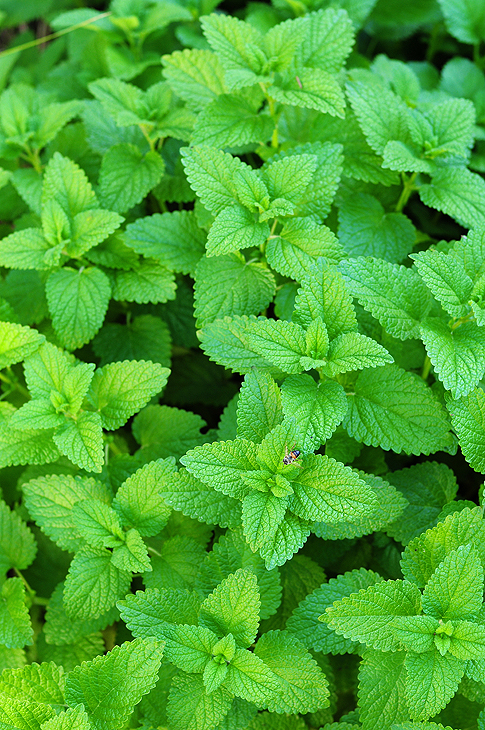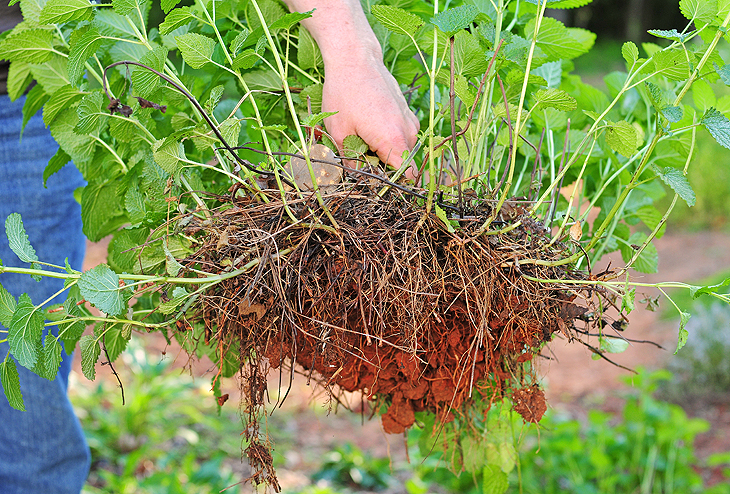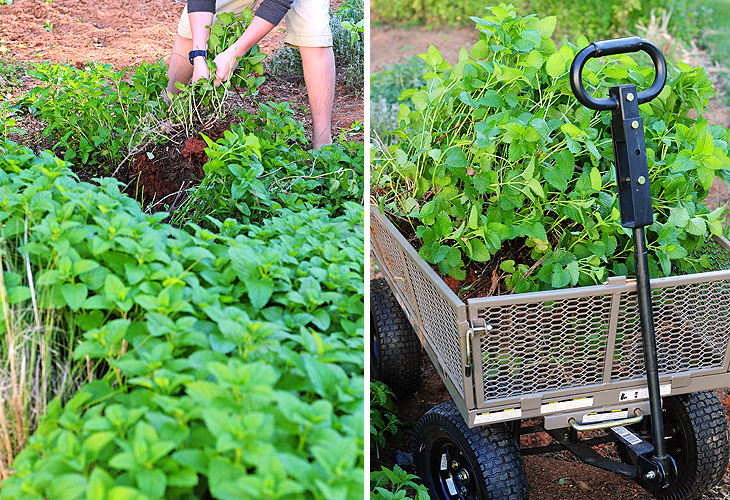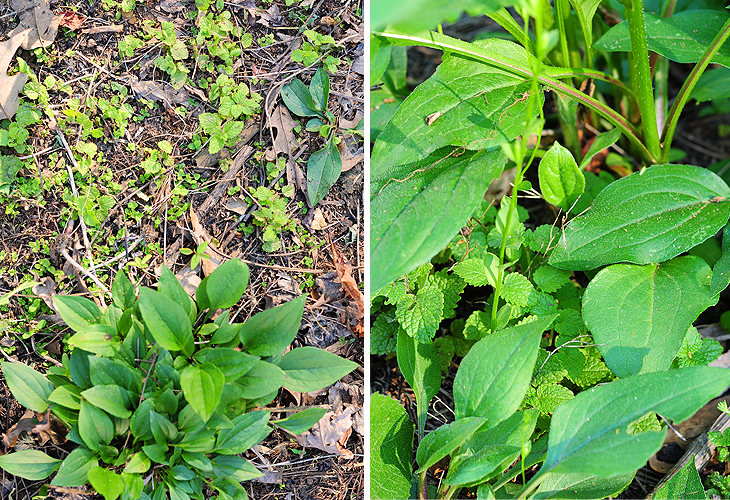Lessons in Lemon Balm
This post may contain Amazon or other affiliate links. As an Amazon Associate I earn from qualifying purchases.
It seems I like to learn things the hard way.
I think I actually have a knack for learning things the hard way. You know, by making mistakes over and over again? Learning by doing it the wrong way may really be the best way in the long run for me. Those hard-learned lessons stick with me much better. They get locked in. Locked way in.
Take Lemon Balm, for example. You would have thought I’d learned from planting mint to read a little bit more about the plants I choose for my garden spots. But no, I chose the leathery leafed lemon balm (Melissa officinalis), that closely resembled mint in so many ways, without a second thought as to what I may be adding to my vegetable and herb garden.
It’s been a healthy green beautiful plant, but like mint, it has spread quite a bit. I’ve pulled up a few clumps here and there, but have had to resign to the fact that a major removal was in need. It pains me to pull up such healthy plants, but it’s become quite invasive.
To me, lemon balm is much worse than mint’s wandering ways. Oh, they’re similar, actually more than similar. Lemon balm is part of the mint family, and spreads just like mint and become very invasive. I can’t imagine how many yards of mint and lemon balm roots I’ve pulled up. But from what I’ve learned this week, and boy have I learned, mint sends out roots with single shoots surfacing above ground. Lemon balm is more sneaky. It develops more in clumps than the mint, very strong, interwoven clumps. I’ve had an easier time pulling up mint over the years.
Getting lemon balm out of the ground once it has spread into, say … where you’ve been trying to get tarragon to grow for two years, is pretty much a pain. Or maybe where a walkway used to be? Or perhaps crowding out the purple coneflower that you’d rather see spread. Yes, you could say that lemon balm and I have had an intimate relationship over the past week. After days of trying to rid it from my vegetable garden, I’m quite appreciative of it’s hardiness. It’s a tough bugger.
We’re not tossing it all. Our new garden cart came in handy this weekend for carrying a good amount of it to be transplanted to another part of our yard where it can grow without crowding out anything else.
And with all the little ones left scattered around, and hiding under the coneflower that I want to keep, I know I’ll still have some lemon balm to battle in this particular garden spot for a while.
I did turn to the internets to see if there was an easier way to get the tough stuff out of the ground other than pulling and digging. After a search for “how to kill lemon balm,” I was surprised to learn even more about this multi-purpose pain in my neck. I originally planted it after reading about it’s mosquito repelling qualities, and various culinary uses, but, come to find out, there’s more to lemon balm than some nice smelling tea.
Really, I shouldn’t be so hard on it. Throughout history, lemon balm has been found to have so many useful purposes. According to the North Carolina Cooperative Extension Service of North Carolina State University lemon balm has been used:
- medicinally, for it’s mild sedative properties. (Hmmm…?)
- to help relieve gas, reduce fever and increase perspiration. (Alrighty then.)
- for it’s antibacterial and antiviral properties.
Other references I read spoke of lemon balm’s soothing ability, of the mind, as well as the skin. Anti-stress is always a good thing, and smooth skin too? Sign me up!
So go ahead and plant some lemon balm. Just plant it in a pot, or a place in your yard where you can’t get anything else to grow. Maybe you’re trying to prevent erosion on a slope somewhere? Try planting lemon balm. Maybe you’re tired of cutting grass, but want something that is not only green, but smells like fresh lemons? Plant lemon balm. Maybe you’ve hoped and dreamed of having a crop of something to make your own tea or delightful beverages with? Plant you some ding, dang, dong lemon balm. It will be happy you did.
Of course, before spending time and money, check zone and soil requirements for lemon balm first to see if you can grow it in your area.
I for one, will not be planting any more lemon balm any time soon. It has taught me well. Yes indeed. I’ve learned this lesson the hard way.
Happy gardening!








Good info! I’m in AZ, have some lemon balm in a pot now. Was considering putting in the ground before reading your post. Whereabouts are you? Your Sunset climate zone or USDA hardiness zone would be helpful. Thanks!
Oh dear! I’ve just planted some this year. I better see to it before it overtakes my herb garden! Yikes! I am so glad I read your tale before I, too fell prey to the wandering ways of the lemon balm. I’ll need to put this on my garden to-do list for the week. Perhaps I’ll go park it in a pot next to my wayward mint!
By they way I am really enjoying your blog! Stumbled here from a pin on Pinterest. Looking forward to reading more.
I just came across your blog on blogher, and i love your style of writing! I love in North Carolina and write about a myriad of things including gardening also. i’m just getting started really, so I’ll be interested in following your blog. i think we have some similarities in our views on life, I mean that as a compliment, to both of us I guess! LOL I also have lemon balm that has run amok in my garden! I have to get to work on containing it! Thanks for the post, looking forward to seeing more! Helen
I think if you have something spreading like this it is not responsible to just stick it in some uncultivated area to spread unchecked. It is also not responsible to give some to all your friends. Burn unwanted plants. Your neighbors (both human and wildlife) may not want it. Invasive plants are a form of litter that reproduces and a huge threat to native plants and the wildlife dependent on them.
Just a heads up to You all wanting to make lemon balm tea: it is lovely and really does soothe and assist with sleep but the fresh herb is STRONG so start with literally a couple of leaves per cup. I have been studying herbalism for years but when I saw this sweet little beautiful plant I just dove in wanting to enjoy the amazing aroma and health benefits. Well I did alright. I passed out into a 7 hour nap full of extremely fluid dreams and woke up with a hangover. All things in moderation!
Love reading all of the great comments. I do want this for a potted plant on my deck for mosquito purposes 1st. Do I find this in seeds? I do not know of anyone in my area having this plant (Edgemere, MD)
I have found lemon balm in seedlings or seeds.
Your article was so informative! And now my battle begins. It’s growing unchecked. I too hate to destroy such a lush healthy plant, but I must be strong! SHOW NO MERCY has to be the song in my head!
I have lemon balm growing under my pine trees and I think it looks WAY better than all those dead pine needles!